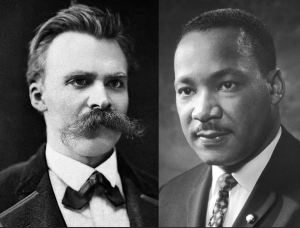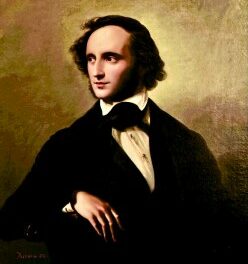We support our Publishers and Content Creators. You can view this story on their website by CLICKING HERE.
 On December 22, 1808, Ludwig van Beethoven—by then an established composer and a renowned piano virtuoso—conducted a concert of his own works, featuring himself also as pianist, at the Theater an der Wien in Vienna. The program included the premiers of Beethoven’s Fifth and Sixth symphonies, his Fourth Piano Concerto, and a concluding piece for piano, orchestra, and chorus (the Choral Fantasy) that Beethoven barely finished in time for the concert. Also on the program were Beethoven’s concert aria Ah! perfido and the Gloria and Sanctus sections from the composer’s Mass in C. Because church music per se was banned from secular theaters, Beethoven listed these latter pieces in the night’s program as “Hymn and Sanctus with Latin text, composed in the Church style with chorus and solos.” The penultimate piece that evening was to be a fantasy for solo piano played by the composer, but it is not clear whether this was actually performed at the concert; some claim that the piece was what came to be Beethoven’s Op. 77, the Fantasia in G minor.
On December 22, 1808, Ludwig van Beethoven—by then an established composer and a renowned piano virtuoso—conducted a concert of his own works, featuring himself also as pianist, at the Theater an der Wien in Vienna. The program included the premiers of Beethoven’s Fifth and Sixth symphonies, his Fourth Piano Concerto, and a concluding piece for piano, orchestra, and chorus (the Choral Fantasy) that Beethoven barely finished in time for the concert. Also on the program were Beethoven’s concert aria Ah! perfido and the Gloria and Sanctus sections from the composer’s Mass in C. Because church music per se was banned from secular theaters, Beethoven listed these latter pieces in the night’s program as “Hymn and Sanctus with Latin text, composed in the Church style with chorus and solos.” The penultimate piece that evening was to be a fantasy for solo piano played by the composer, but it is not clear whether this was actually performed at the concert; some claim that the piece was what came to be Beethoven’s Op. 77, the Fantasia in G minor.
Though the Theater an der Wien, which had opened in 1801 and which had been the site of other Beethoven premiers, was known as one of the best and most comfortable theaters in all of Europe, the heating system in the venue was broken that evening, and the concertgoers who attended were compelled to endure the cold over the course of the four-hour concert. They were also subjected to a subpar performance of the aria by a nervous, young soprano soloist named Josephine Killitschgy (who was filling in for the original singer, Anna Milder, who dropped out after Beethoven insulted her) and less than stellar playing from the orchestra. Beethoven’s deafness at this point, which was only partial and was better and worse at times, may have had some ill effects on his playing and conducting. However, it was certainly the lack of rehearsal time for the Choral Fantasy that led to the performance of that piece completely breaking down; Beethoven in fact stopped the orchestra and had them start the work again from the beginning. Whether the fault was the orchestra’s or Beethoven’s is unclear. Beethoven at first blamed the orchestra for miscounting rests but later seems to have assumed responsibility for incorrectly playing a repeat of one section for piano.
Between the chilly temperatures inside the theater and the faulty execution of the musical scores, the concert failed to make the impression for which Beethoven had hoped. “There we sat, in the most bitter cold, from half past six until half past ten,” recalled one attendee, “and confirmed for ourselves the maxim that one may easily have too much of a good thing, still more of a powerful one.” One local newspaper commented: “To judge all these pieces after one and only hearing, especially considering the language of Beethoven’s works, in that so many were performed one after the other, and that most of them are so grand and long, is downright impossible.” Beethoven’s assistant, Anton Schindler, said that the concert “simply fell apart.”
Despite these less than ideal conditions, few music lovers today would refuse a chance to go back in time and be present for a concert that premiered the masterworks that are the Fifth and Sixth symphonies and the Fourth Piano Concerto, as well as the underrated masterpiece that is the Choral Fantasy, a work that very much prefigures the Ninth Symphony in its progress from musical darkness to light and in its use of voices at its conclusion singing a tune and words reminiscent of the “Ode to Joy” section of that immortal piece.
Beethoven’s Original Program:
First Part:
1, A Symphony, entitled: ‘A Recollection of Country Life,’ in F major (No. 5).
2, Aria.
3, Hymn with Latin text, composed in the Church style with chorus and solos.
4, Pianoforte Concerto played by himself.
Second Part:
1, Grand Symphony in C Minor (No. 6).
2, Sanctus with Latin text composed in the church style with chorus and solos.
3, Fantasia for pianoforte alone.
4, Fantasia for the pianoforte which ends with the gradual entrance of the entire orchestra and the introduction of the Choruses as a finale.
Note that Beethoven initially listed the Pastoral symphony as “No. 5” and the now-famous “Fifth” as “No. 6. Upon publication of the scores, he would reverse this order.
Spotify playlist of this concert (subscription required):
For more on the concert of December 22, 1808, see “For the Love of Ludwig” by Paul Hume in The Washington Post, and Robert Greenberg’s “Great Masters: Beethoven—His Life and Music” on Audible, and the Wikipedia entry for this event,
This essay is part of a series commemorating the 250th anniversary of the birth of Ludwig van Beethoven.
This essay was first published here in December 2020.
The Imaginative Conservative applies the principle of appreciation to the discussion of culture and politics—we approach dialogue with magnanimity rather than with mere civility. Will you help us remain a refreshing oasis in the increasingly contentious arena of modern discourse? Please consider donating now.
The featured image combines an oil painting of Ludwig van Beethoven (1815) by Christoph Heckel (1792–1858), which has been brightened for clarity; and a depiction of the Theater an der Wien (1815) by Jakob Alt (1789 – 1872). They are both in the public domain and appear here courtesy of Wikimedia Commons.
Share This Story, Choose Your Platform!
Go to Top

 Conservative
Conservative  Search
Search Trending
Trending Current News
Current News 






